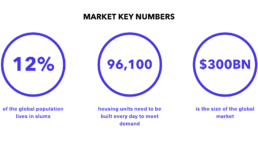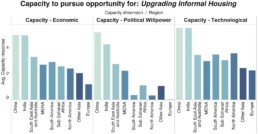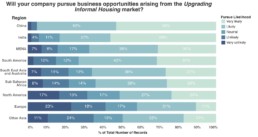Improving living conditions in slums by focusing on upgrading housing has the potential to transform these communities into healthy and safe neighbourhoods while spurring innovation in the architecture, design, and engineering markets. This is an untapped market for business to enter, which demands solutions that combine resilience and affordability.
Upgrading living conditions in slums will become critically important as climate change intensifies. These communities – typically found in megacities – are home to 12 percent of the world’s population, and their houses are more liable to collapse in extreme weather events. Upgrading homes in slums and informal settlements is a space for innovative, affordable, and resilient housing.
According to award-winning architect Alejandro Aravena, architects will need to build the equivalent of 1-million-person city every week for the next 15 years – with a budget of just 10,000 USD per family.
Slum residents are innovative and entrepreneurial by necessity, having created homes and infrastructure from seemingly impermanent materials and scarce resources. Hence, when developing and deploying solutions for housing in slums, there is an opportunity for mutual learning and innovation rather than a one-way exchange of products. This process of mutual listening and learning has the potential to foster innovative solutions relevant to the global market, combining resilience and affordability – a winning formula in any market.

Products and Services
Investing in housing in slum communities has an array of positive and multiplying side effects, such as providing residents with the ability to divert their energy towards pursuits other than simply keeping a roof over their heads. Slums contain both an opportunity space for new products and services, as well as new investment opportunities. Products and services in this opportunity space include whole-building retrofitting; climate-proofing adaptation add-ons, such as affordable compressed gravel flooring to combat health problems from dirt floors; energy-positive and pre-fabricated houses; reusable air filters and building material; sustainably sourced low-cost bricks and mortar; and coatings that have a cooling effect and absorb pollution.
Building half houses is a piloted approach in the favelas of Chile, where slum dwellers use their savings and government subsidies to get help from an architect to build half a house, with the shell for the other half to be completed over time. The owner of the house completes the other half as they gain resources for the materials. Hence, once the entire house is completed it is truly co-created by architects and residents.
Market Size and Demand Drivers
Market reports on the slum housing market are virtually non-existent. However, with 828 million people around the world residing in slums, the number of potential consumers is important and growing. The number of people moving to urban areas is increasing every day, and housing supply in slums is nowhere near meeting the growing demand, which is projected to double by 2030.
Considering the enormous demand and substantial size of the low-income housing market, which is worth more than 300 billion USD globally, surprisingly few market-based approaches exist to provide housing solutions for poor people residing in slums.
Survey Findings
Upgrading informal housing in slum communities is not among the most popular market opportunities surveyed in 2016. The regions which most favor this market is China and the MENA region.

A very low perceived capacity to develop this market across all surveyed regions indicates a lack of belief in the potential of this opportunity. In fact, respondents have evaluated the political, economic, and technological capacity to be lower than the 14 other market opportunities in the 2016 survey. Nevertheless, respondents in China – where it is a popular opportunity – evaluate the overall capacity to mature this market higher than all other regions. Hence, the market for delivering housing to slum residents can be expected to mature faster in China relative to other regions.
Globally, respondents do not believe their organisations are likely to be positively impacted by the opportunity, nor do they expect their organisations will engage in this market opportunity. The leaders surveyed perceive the business case to be less attractive.

The financial sector ranks this market opportunity highest with regard to its likelihood of pursuing it; however, no business sector is truly eager to pursue this opportunity compared to the other opportunities surveyed in 2016. The majority of business sectors believe this opportunity has little positive impacts on society. The survey reveals it is the market opportunity business is most likely to actively advocate for in China, which supports the notion that the market for slum housing can be expected to mature fast in China.
This market was surveyed globally in 2016 by more than 5500 leaders from both the public and private sectors. The survey was conducted in collaboration with the research company YouGov. The survey results were originally published in the Global Opportunity Report 2017.

